15 Glute Activation Exercises That Make Your Glutes Pop
Glute activation has become a popular buzzword in the fitness world, but what does it mean? And more importantly, does it actually work?

Truth be told that toning and reshaping your glutes takes a much more comprehensive strategy than just doing some squats and lunges.
Without proper muscle recruitment, activation, and mind to muscle connection, you can do all the squats, lunges, and deadlifts in the world but progress with be slow or impossible.
Glute activation exercises are designed to fire up the gluteal muscles and improve the mind-to muscle connection to maximize your glute gains.
So, if you’re serious about developing your glutes, get ready.
These are the best exercises to wake up those sleepy glutes and prepare them for building a strong backside and sexy legs all year long!
So, let’s get started!
Disclosure: Although I am a certified prenatal/postnatal exercise specialist, Kinesiologist and personal trainer, I am not YOUR trainer. The content on this blog is for informational purposes only and should not be a substitute for the information and advice you receive from a healthcare professional.
What Are The Glute Muscles?
The glute muscles are actually three separate muscles.
These muscles work together to:
- stabilize the pelvis and proper pelvic alignment
- allow movement in the hip and thigh
- propulsion when walking and running
- balance
- prevent injuries in the low back and knees
- allow for hip extension
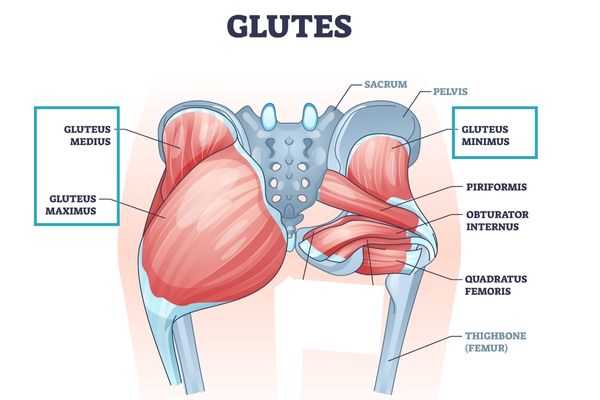
What Causes Weak Glutes?
Have you heard the term, “use it or lose it”?
Increasingly sedentary lifestyles and inactivity are the most common reasons for muscle atrophy, including the glutes.
One theory is that excessive sitting can cause the hip flexors to tighten and the glute muscles to stretch.
This imbalance can cause the glute muscles to essentially “go to sleep” resulting in something referred to as “gluteal amnesia” or “dead butt syndrome.”
This is because other muscles end up compensating for the glutes and over time, the glutes become weak because other muscles have picked up their slack creating muscle imbalances.
These imbalances can lead to pain, injury, poor athletic performance or a “pancake booty” because the muscles are not being stimulated properly.
Why would the glutes have to work if other muscles are doing their job?
This is obviously not effective and can lead to pain and or injury.
What is Glute Activation?
Glute activation exercises can help get the blood flowing to the muscles and improve the mind-muscle connection to improve stimulation and function of the muscles.
Think of glute activation as giving your muscles a little wake-up call before you start your workout.
The “burn” you feel from performing these exercises also signals the brain to recruit the glute muscles.
It’s important to note that glute activation exercises are not the same as traditional compound movements like squats and lunges.
They are used as a warm up to heavier resistance training as a way to improve mind-to-muscle connection and “wake up” the muscles.
Why Is Glute Activation Important?
A common problem that a lot of people run into is that they have poor muscle recruitment of their gluteal muscles as a result of more sedentary lifestyles.
Weak, unresponsive glute muscles not only interfere with your glute gains, but can also lead to a whole host of other problems like knee pain, hip pain, and lower back pain.
This is because inactive glutes cause other muscle groups in your lower body to work harder to pick up the slack.
Over time, this can lead to muscular imbalances, injuries, or chronic pain.
Glute activation exercises can help improve the mind-muscle connection so you can better activate the glutes during your workouts or in daily activities such as walking or climbing stairs.
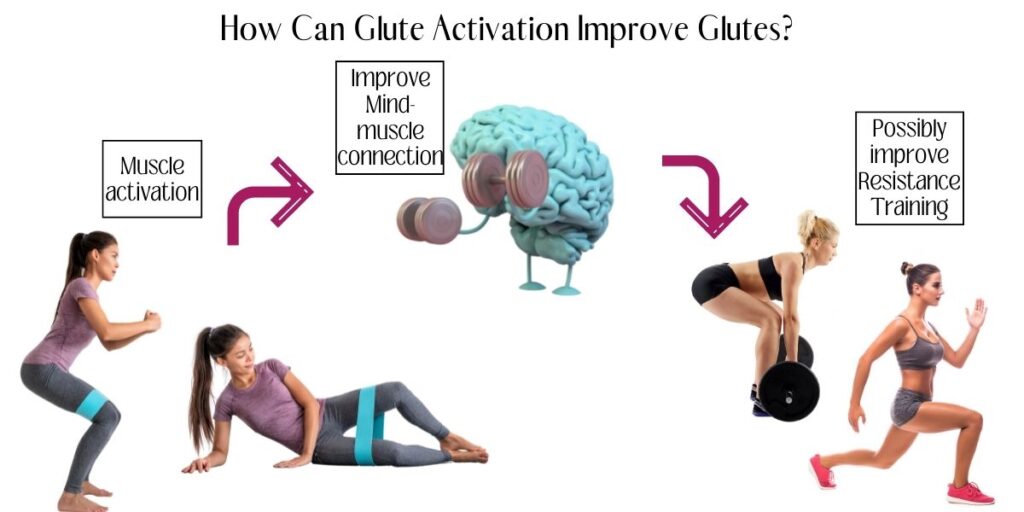
Why Are Strong Glutes Important?
The glutes are the largest muscle group in the body, so strengthening them can have a major impact on both your aesthetics and overall fitness.
Strong glutes prevent imbalances in the hips and pelvis which can cause injury and pain in the lower back, knees, and hips.
Furthermore, strong glutes help to decrease the risk of injury, improve posture and hip stability, and can even make everyday activities easier such as standing or walking.
And if you are a mom, there is a good chance that you lost a lot of glute strength during pregnancy.
If you struggle with pelvic floor dysfunction, chronic back pain, poor posture, or a “mom butt” after pregnancy, chances are your glutes are not firing on all cylinders.
And last but not least, weak glutes really hinder athletic performance.
Whether you are an active runner or a weight lifter, strong glutes are essential for explosive movements, power, and speed.
How Do I Know If My Glutes Are Weak?
Here are a few signs of poor glute activation.
Tight hip flexors
When the glutes are not firing properly, the hip flexor muscles have to work overtime in movements as simple as walking, running, or squatting.
This can lead to muscle tightness as well as lower back pain.
Dominant or tight hamstrings
If you feel your hamstrings working in glute-focused exercises such as hip thrusts or squats, it’s a good chance your glutes are weak and the hamstrings are taking over the exercise.
Anterior pelvic tilt
An anterior pelvic tilt is when the front of your pelvis tilts down and the back of your pelvis tilts up.
This is very common in pregnant and postpartum women due to the anatomical changes that happen to our bodies during pregnancy.
This can cause several problems such as lower back pain, knee pain, and hip pain.
If you notice that your posture looks like your butt is sticking out and chest is tilted forward, it could be a sign that both your core and glutes are weak.
Low back pain
Weak glutes can cause over-compensation of the low back muscles leading to pain and injury.
Knee pain
If you notice your knees “cave in” during squats or when you walk, it could be a sign of weak glutes.
Test “Do I have Weak Glutes?”
These five tests will give you a good indication if your glutes are working as efficiently as they should.
Test #1-Mobility
Do you feel your glutes “working” during lower body exercises such as squats, lunges, or hip thrusts?
Are you able to do these exercises with proper form?
If you feel most of these exercises in your quadriceps, hamstrings, or lower back then your glutes are probably not working efficiently.
Test #2-Strength
Perform this exercise and pay attention to what muscles you feel working the most.
Bridge and Single Leg Bridge
- Begin by lying on your back with your knees bent.
- Engage your core and glutes to lift your hips off the ground into a bridge position.
- Hold this position for about 10 seconds while paying close attention to what muscles you feel working.
- Relax then repeat the movement but with one leg in the air for a single leg bridge.
- Notice what happens to your hips. Do they drop to one side as you bridge up?
- If you feel this exercise more in your hamstrings, lower back, or even quads, then your glutes are not doing their job.
Test #4 – Function
Ask yourself these questions:
- Do you have an anterior pelvic tilt?
- Do you have knee pain?
- Do your knees cave in when your squat? If you cannot cannot squat without your knees caving in or experiencing pain, then it’s likely that your glutes are weak.

What Are The Best Exercises To Activate Your Glutes?
The question on everyone’s mind is, “what are the best glute activation exercises?”
Well, there isn’t one answer for all people.
The best exercises will be the ones that help you learn to properly engage your glutes the best.
Focus on targeting all three major glute muscles: the minimus, medius, and Maximus.
It is important to make sure that you’re doing a variety of different exercises to target all three gluteal muscles.
This will help you to achieve more balanced glute development and avoid any potential imbalances or injuries down the road.
Use this list to help you find the exercises that your body needs most.
Equipment needed
Glute Bridge
- Lie on your back with your feet flat on the floor and your knees bent. You can place a mini band around your knees which will help activate your hip abductors (glute medius) but this is optional.
- Place your hands on the floor for stability and relax your upper body.
- Engage your core and squeeze your glutes to lift your hips off the floor, making sure to keep your back flat.
- Hold the position for a few seconds, then lower your hips back down to the starting position.
- Repeat 12-15 reps
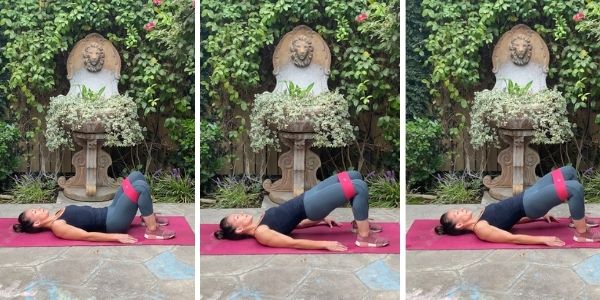
Single Leg Bridge
- Repeat the same movement as a glute bridge but with one leg in the air for a single leg bridge.
- Focus on performing the movement to prevent your hips from tilting. The goal is to keep the pelvis straight and core engaged.
- You do not need to lift very high on this exercise.
Hip Thrusts with Mini Band
The hip thrust is a great exercise for glute activation as well as growing the glutes.
Once you feel strong with just your body weight, you can add a barbell or dumbells on your hips to add resistance.
You can use a mini band around your knees to activate the abductors but this is optional based on what feels best for your body.
- Start by sitting on the ground with your back against a bench or chair.
- Place your feet flat on the ground and legs bent to 90 degrees.
- The bench should be right below your shoulder blades.
- Engage your core to bring your hips neutral and drive your heels into the ground while squeezing your glutes to lift your hips off the ground.
- Keep your gaze looking forward and thrust your hips up toward the ceiling, keeping your back straight and core engaged.
- Hold for a second or 2 at the top, then slowly lower your hips back down to the starting position.
- Repeat 12-15 reps until strength improves then add resistance.
Single Leg Hip Thrust
The key to doing this exercise correctly is to keep your core engaged by tucking your pelvis so your hips stay level.
Imagine you are tilting your pelvis toward your rib cage. Here’s how to do it:
- Lie on your back with your knees bent and feet flat on the ground.
- Keep your right foot flat on the ground and extend your left leg straight up into the air.
- Brace your core and drive your right heel into the ground, lifting your hips off the ground until your thighs and torso are in a straight line with each other.
- Hold for 2-3 seconds, then hinge at the hips to slowly lower back down to the starting position. Your glutes should be engaged to control as you lower.
- Repeat 8-10 times, then switch sides.
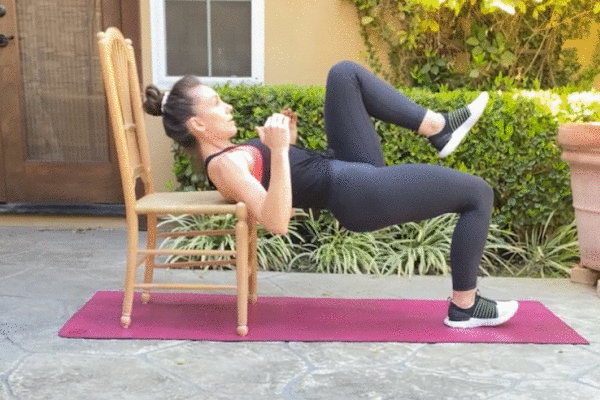
Side-lying Hip Abduction or Wall Hip Abductions
- Lie on your left side with your left leg bent to 45 degrees and your right leg straight on top.
- Stack your hips and shoulders directly on top of each other to avoid rolling the hips forward or back. You can also lie with your back flat against a wall for better support.
- Engage your glutes to lift the upper leg toward the ceiling. Imagine leading with the heel. Place your top hand on your top glute to feel the muscle working.
- If you are against a wall, you can place a towel under your heel and slightly press your heel into the wall as you slide your leg up and down.
- Squeeze your glute for 3-5 seconds then slowly lower the leg.
- Avoid overextending because then other muscles start compensating.
- Complete 12-15 repetitions.
Clam Shell
- Lie on your side with your knees bent and your feet together.
- Place your hand on your hip and rest your head on your arm.
- Keeping your feet together and core engaged, exhale as you squeeze your glutes to lift your top knee as high as you can without moving your hips forming a “clamshell”.
- Hold for a count of two, then slowly lower your knee back to the starting position.
- Repeat for 8-12 repetitions, then switch sides and repeat.
Fire Hydrant
- Start in a tabletop position with your shoulders above your wrists and hips over your knees.
- Keeping your core engaged, lift one knee up and out to the side, keeping your knee bent at a 90-degree angle.
- Squeeze your glute as you raise your knee, and hold for a few seconds before lowering back down.
- Repeat for 10-12 repetitions then repeat on the other side.
Donkey Kick
- Begin on your hands and knees with your wrists directly under your shoulders and knees directly under your ankles.
- Begin with your right leg. Keep your core engaged to prevent movement in your hips, engage the glute and extend your leg straight up, keeping your knee bent.
- Imagine driving the sole of your foot into the ceiling. Kick up until your thigh is about parallel with the ground then lower.
- You can also place a mini band around your knees for a little resistance.
- Repeat for 12-15 repetitions then switch sides.
Glute Bridge March
- Begin on your back with your knees bent and feet flat on the ground. Your feet should be hip-width apart.
- Engage your core to prevent arching your back then press through the heels and squeeze your glutes to lift your hips off the floor.
- Your body should form a straight line from your shoulders to your knees.
- Squeeze your left glute as you pull your right knee toward your chest. Pause then lower the leg and repeat on the other leg.
- Focus on using your glutes and core to prevent your hips from tilting.
- Continue alternating back and forth.
- Complete 10-12 reps for each leg.

Lateral Band Walks
- Carefully place a mini band around both legs just above your knees.
- Engage your core and lower into a half squat position with your feet shoulder-width apart.
- Staying low, initiate the movement by pushing off your left foot and taking a lateral step toward the right with your right foot.
- Slowly bring the left leg toward the center (but not all the way touching) and repeat the movement by pressing off the left foot and laterally stepping with the right foot.
- Complete 12-15 repetitions then switch directions.
Standing Glute Kickbacks With a Mini Band
- Begin in the standing position and place a loop band around your ankles. You may need to hold onto something for support or not.
- Stand with your feet shoulder-width apart to keep the band taught.
- Place your hands on your hips or something for support and engage your core. Engage your right glute and lift your foot off the ground behind you in a slight diagonal angle and toes pointing down.
- Focus on keeping your leg straight and leading with your heal.
- Slowly bring your right foot back to the center and repeat.
- Complete 10-15 repetitions then switch sides.
Hip Hike
- Start by standing with your right leg on a low step or stool.
- Carefully lower your left foot so that your right hip pushes out to the side.
- Now engage your right glutes to bring your left leg up and your pelvis is even.
- This is activating the glute medius which is what helps keep your pelvis level.
Monster Walks
- Place a loop band around your ankles or your knees and stand with your feet hip-width apart and a slight bend in your knees. The higher you place the band, the easier the exercise will be.
- Take a giant diagonal step forward with your right foot while keep the left foot firmly planted to the ground, resisting the pull from the loop band.
- Keep your hip bones straight and level.
- Follow with your left foot, stepping it out diagonally and in front of you.
- Continue walking forward, resisting the pull on the loop band for 10-12 steps reverse the exercise and walk back to the starting position, stepping back and diagonal for 10-12 reps.
Band Pull Throughs
- To set up this exercise, you will need a large resistance band or a cable machine at the gym.
- If you are using a band, anchor it around a pole, or doorway using one of these or these (which is really handy to have at home!)
- Step over the band with your back toward the anchor and then reach down to grab the band.
- Take a few steps forward and plant your feet firmly. Your shoulders should be down away from your neck and your arms straight.
- With a slight bend in your knees, hinge forward until your torso is parallel with the floor. You may feel the band wants to pull you back but keep your glutes engaged to maintain your balance.
- Engage your glutes by imagining you are pulling string from the back wall with your glutes and drive your hips forward until you have reached a standing position. Do not hyperextend your lower back.
- Slowly hinge at the hips and return to the starting position.
- Repeat 12-15 reps.
- Once you get stronger, increase the resistance to build more glute strength.
Seated Mini Band Adductors (Tri-set)
- Begin by sitting on a sturdy bench or chair and place a firm resistance band on your thighs just above your knees.
- Engage your core and sit up straight.
- Begin by sitting close to the edge of a bench and place your hands behind you for support.
- Keep your core strong and engage your glutes to press your knees out against the band as you slightly lean back.
- Complete 10-15 reps then sit straight up.
- Complete 10-15 reps then lean your body forward to complete the last 10-15 reps.
- All three sets count as one tri-set. Complete 2-3 sets.
Reverse Single Leg Lift
- Begin lying face down with your forehead resting on your hands. You can place a mini band around your ankles for added resistance.
- Engage your core and keeping your leg straight, squeeze your right glute to lift your leg up toward the ceiling, leading with your heel.
- Pause for 2-3 seconds, then slowly lower.
- Complete 12-15 reps then switch legs.
- Focus on engaging the glute and not your hamstrings to get the most out of the exercise.
10-Minute Glute Activation Workout
Give these warm-ups a try and see if you notice a difference in your lower body workouts.
| Exercise | Reps |
|---|---|
| Glute Bridge with loop band | 15 |
| Lateral band walks right | 12-15 |
| Lateral band walks left | 12-15 |
| Standing glute kickback | 12-15 per leg |
| Side-lying Hip Abduction | 12-15 each leg |
| Instructions | Complete each exercise in the circuit then repeat 2-3 circuits |
| Exercise | Reps |
|---|---|
| Single leg glute bridge | 12-15 per leg |
| Donkey kicks | 12-15 per leg |
| Fire Hydrant’s | 12-15 per leg |
| Reverse single leg lift | 12-15 per leg |
| Instructions | Complete each exercise in the circuit then repeat 2-3 circuits |
| Complete this set as a burnout after your workout (2 sets) | Seated Mini Band Adductors (Tri-set) |
How Often Should You do Glute Activation Exercises?
There is no one-size-fits-all answer.
The frequency of glute activation exercises will vary depending on your goals, training schedule, and physical anatomy.
However, if you’re looking for the best results, then I recommend aiming to do some sort of activation work 3-4 times per week.
This will ensure that your muscles are consistently being stimulated resulting in greater gluteal function, growth, and development over time.
It will also help prevent muscle imbalances which can lead to injury or compensation of different muscles.
Does Glute Activation Grow Glutes?
Contrary to what you see on social media, glute activation exercises are not great for making glutes bigger.
These exercises are used as accessory exercises to a weight lifting program.
If you want to grow your glutes, you need to focus on resistance training exercises that build muscle, like squats and lunges.
However, while glute activation exercises may not directly grow your glutes, they can certainly help to shape and sculpt them by stimulating the muscle to prepare them resistance training.
But keep your expectations in perspective. Genetics plays a large role in the shape and size of your glutes.
Just because you weren’t born with a Kim Kardashian booty, doesn’t mean you can’t have a strong, shapely butt!
Do Glute Activation Exercises Really Work?
There has been a lot of talk in recent years about whether or not glute activation exercises actually help improve glute function for strength training and performance.
Some people swear by them and say they’ve seen a significant difference in their booty gains (myself included), while others find them to be less effective.
In my personal and professional opinion, glute activation exercises can help to improve the mind-to-muscle connection which can lead to better results from your lower body workouts.
Ultimately, it’s up to you to decide whether or not they are helpful to improve your glute strength, function, and appearance.
There is certainly no harm in including them in your workout routine!
If you’re looking for a little extra help in achieving your #BootyGoals, they may be worth a try!
Final Thoughts on Glute Activation Exercises
When it comes to glute activation exercises, there are a few things you need to keep in mind.
First of all, whether or not they are effective depends on the person and their goals.
For example, if your goal is to build strong glutes, then you should not rely on glute activation exercises as your primary training method but could be a great compliment to your resistance training workouts.
Not all glute activation exercises are created equal, so make sure you find ones that work for you.
Just like any other muscle group, the glutes need to be trained consistently in order to see results.
So if you’re looking for a way to mix things up and keep your glutes firing, then give glute activation exercises a try.
The good news is you have nothing to lose doing activation work!
FACT CHECK
Struggles of a Fit Mom uses only high-quality sources, including peer-reviewed studies, to support the facts within it’s articles. Read my editorial process to learn more about how I fact-check and keep my content accurate, reliable, and trustworthy.
https://pubmed.ncbi.nlm.nih.gov/29484248/
https://pubmed.ncbi.nlm.nih.gov/31440415/
https://www.tandfonline.com/doi/abs/10.3109/09593985.2011.604981?journalCode=iptp20
https://www.ncbi.nlm.nih.gov/pmc/articles/PMC5530111/
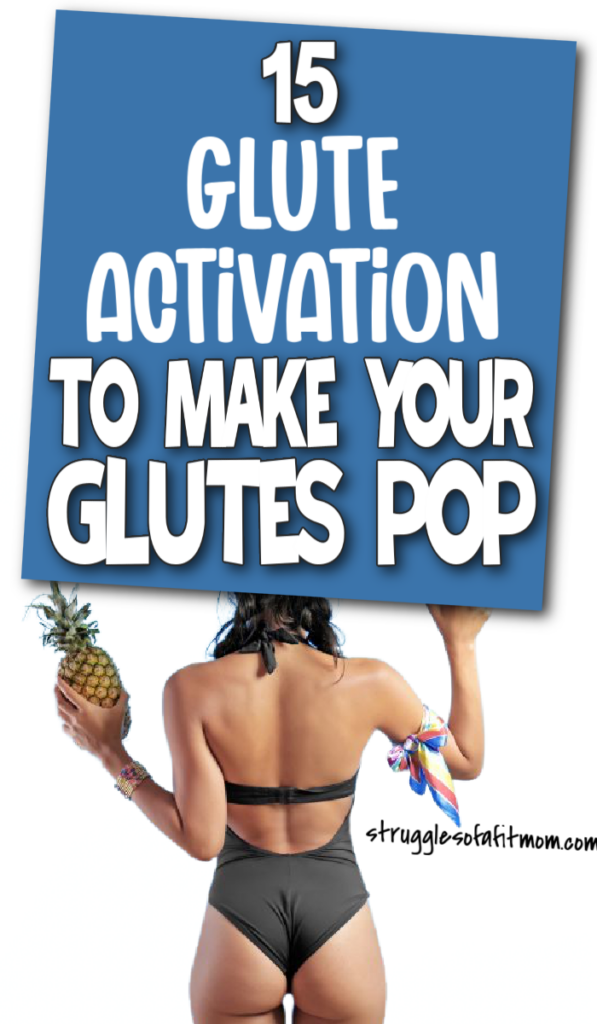

Brooke is a certified Prenatal and Postnatal Exercise Specialist with a Bachelors of Science degree in Kinesiology-Exercise Science. She is also a mom of 3 girls with more than 15 years of experience in health and fitness. Brooke’s goal at Struggles of a Fit Mom is to help motivate, educate and inspire other busy mamas who struggle with finding time, energy and motivation to take care of themselves in the chaos of motherhood.

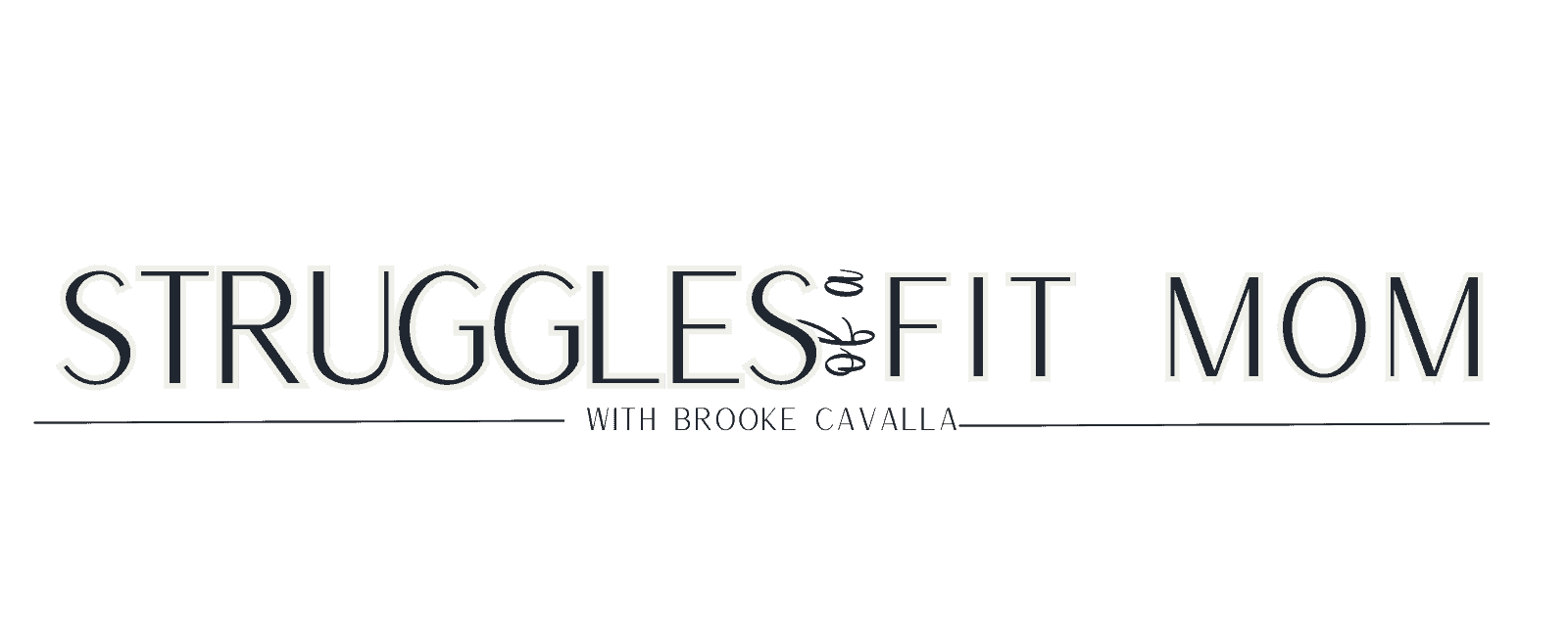

![8 Tips To Make Your Days a Breeze [as a Stay at Home Mom]](https://www.strugglesofafitmom.com/wp-content/uploads/2020/09/Blank-450-x-450.png)



![Tackle “Bat Wing” Arms For Good-[23 Best Exercises]](https://www.strugglesofafitmom.com/wp-content/uploads/2022/06/Blank-400-x-600-copy-22.jpg)